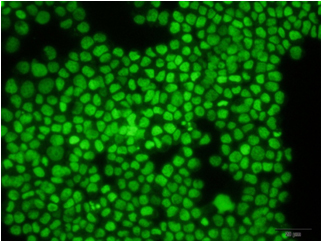EasyProbes™ Green 488 Dead Cell Stain is a cell-impermeant stain that emits exceptionally bright, green fluorescence when bound to DNA. Our EasyProbes™ Green 488 Dead Cell Stain is formulated in a ready-to-use solution that is provided in a convenient-to-use dropper bottle. Just tip and drip two drops per ml to stain your cells. EasyProbes™ Green 488 Dead Cell Stain is a useful stain to estimate live/dead cell ratios and to measure cytotoxicity in kinetic live-cell assays. It is also suitable for staining nuclei in fixed cell preparations and tissue sections.
Features
- No need to dilute, weigh, or pipette
- Convenient dropper bottle—just use two drops per mL
- Rapid staining of damaged, dead, or fixed cells without wash steps
Suggestions for use
EasyProbes™ Green 488 Dead Cell Stain may be added directly to cells in full media or buffer solutions. It easily stains nuclei of fixed cells and tissue slices
- In most cases 2 drops/ml and an incubation of 15 to 30 minutes will give bright nuclear staining; however, optimization may be needed for some cell types, conditions, and applications. In such cases simply add more, or fewer drops until the optimal staining intensity is obtained.
- EasyProbes™ Green 488 Dead Cell Stain is excited with a maximum at 500 nm when bound to DNA, with an emission maximum at 530 nm. It is detected through standard GFP and FITC filters.
| Specifications: |

|
|
| Excitation/Emission: | 500/530 nm | |
| Shipping Condition: | Ambient | |
| Storage Conditions: | 4ºC, protect from light | |
| Unit Size: | 10 mL |
| Protocol (PDF): | FP030 |
| MSDS (PDF): | FP030 |
Reference:
Davies BR, Greenwood H, Dudley P, Crafter C, Yu DH, Zhang J, Li J, Gao B, Ji Q, Maynard J, Ricketts SA, Cross D, Cosulich S, Chresta CC, Page K, Yates J, Lane C, Watson R, Luke R, Ogilvie D, Pass M,
Mol Cancer Ther (2012) 11:873-887
The G1 cyclin Cln3p controls vacuolar biogenesis in Saccharomyces cerevisiae.
Han BK, Aramayo R, Polymenis M
Genetics (2003) 165:467-476
Efficient labeling of fission yeast Schizosaccharomyces pombe with thymidine and BUdR.
Hodson JA, Bailis JM, Forsburg SL
Nucleic Acids Res (2003) 31:e134-e134
- EasyProbe™ DAPI Fixed Cell Stain
- EasyProbe™ Hoechst 33342 Live Cell Stain
- EasyProbe™ Propidium Iodide Dead Cell Stain
- EasyProbe™ Green 488 Live Cell Stain
- EasyProbe™ Green 488 Dead Cell Stain
- EMA (Ethidium monoazide)
- EthD-1 (Ethidium Homodimer-1)
- NucGreen™ live-cell nucleic acid stain
- NucGreen™ dead-cell nucleic acid stain
- NucRed™ live-cell nucleic acid stain
- Acridine orange
- DRAQ5™ Fluorescent Probe

